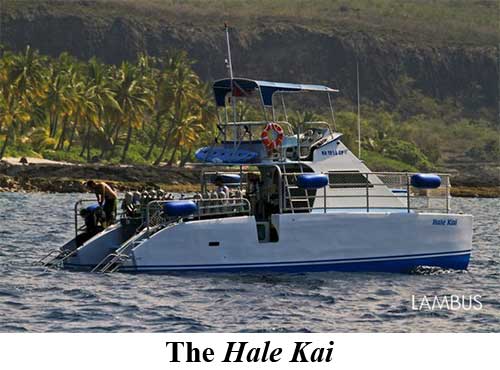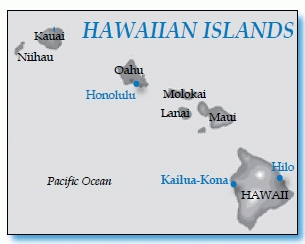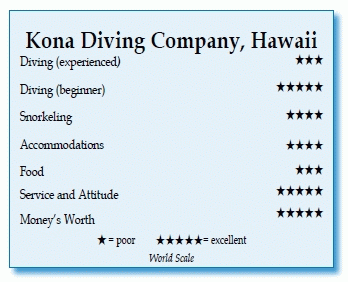Kona Diving Company, Kailua-Kona, HawaiiContents of this Issue: Kona Diving Company, Kailua-Kona, Hawaii Aqua Lung Recalls All BCs with SureLock II Weight Pockets What’s a Heated Vest, and Should You Buy One? Komodo Resort Diving Club, Indonesia The “Ship of Gold” Treasure Hunter Captured In Florida Lionfish Aren’t the Only Invaders in Florida Waters Stop Panic Before It Starts Underwater Dead Diver’s Wife Sues a Shadow Diver Star Want to Put Your Name on a Reef? Got $100,000? Editorial Office: Ben Davison Publisher and Editor Undercurrent 3020 Bridgeway, Suite 102 Sausalito, CA 94965 cool endemic critters and -- with luck -- a manta show from the March, 2015 issue of Undercurrent
Dear Fellow Diver: Groans echoed, along with whooping and blooping, underwater surround sounds that greeted me as I descended into Kona's Arches. Aware that humpback song can travel for miles, I scanned the deep blue in hopes of a rare social encounter, but without luck. Only our divemaster, Katie, briefly saw one whale, but topside all 12 of us were in awe when a small pod breeched and tailed, and several calves somersaulted. It was a fabulous 15-minute acrobatic show, a great welcome to Kona. Regardless, I came here to dive. When I e-mailed queries to several Kailua Kona dive shops, only Kona Diving Company responded promptly and personally to my every question. They were upfront about my needing a rental car to drive to the boat dock, Kona's cold and rough water conditions in February, and they encouraged the "weak of stomach" to use seasick meds. Their motto: Our passion is under the surface, our service is over the top. Picking them was an easy choice. As requested, I dropped by their downtown office the day before my first dive to sign the obligatory release, present my certification card, and meet co-owner Kerry Key. They gave me a map to Honokohau Marina and told me where to find their 34 foot catamaran Hale Kai, or "Ocean House."
On my first day, three divemasters, including Kerry, who did rescue training, were to guide the divers. (One diver was getting his open water certification, another his rescue training.) The catamaran was snug, but manageable. We were encouraged to use the marina restroom before departure because the boat head required a steep ladder descent below decks, and was off-limits to divers with dripping wetsuits. Hanging off the sturdy twin stern ladders was the chosen drainage site, and the crew actually asked if everyone was finished using the ladders before raising them.
While the air hovered around 80 degrees with 20-plus m.p.h. trade winds, the water averaged 72 degrees. I wore a fleece-lined body suit over Underarmour underwear plus a 5-mil wetsuit, hood, and gloves. I envied a few savvy divers and the crew who wore battery-heated underwater vests (see the sidebar on page 4). While we could stay down as long as we wanted -- some stayed as long as 80 minutes -- the chill led me to the surface after an hour. Billy analyzed my nitrox mix prior to every dive (32 percent for the first, 36 percent for the second). Diving between 50 and 75 feet, and with only two dives except for the last day, I wasn't concerned about my Nitrox levels. The other two divemasters were Luke Mason and Katie Key, the owner's niece, who each had around four years of experience and were friendly and knowledgeable. Both Billy and Luke repeatedly asked divers for readings on their air gauges until they were comfortable with their consumption. All three were great at critter spotting. The camera table served as the "food buffet." Kona Diving provided plastic containers with dry turkey, roast beef and veggie wraps, all overwhelmed with sprouts. Everyone helped themselves whenever they wished, but the food was tasteless and boring -- they need a new caterer. The crew, who ate protein bars, referred to the wraps as "guinea pig and raccoon." There were also M&M trail mix and goldfish, a jug of cold water, instant tea, hot chocolate, soup, coffee, soda and super brownies. Around 7 a.m. the second day, I looked out my window at a rainy and windy day. Partially wanting to scrap the dive, I called the shop, but Kerry told me "It's not prohibitive." So off I went for the 8 a.m. departure. At the Aquarium, we swam through a lava tube, timing our entrance with the surge, while Billy waited at the exit to ensure the six of us, finning in a line, had timed our exits with the surge. Later, a sizeable manta swooped overhead, casting a shadow from the new-found sunlight. On the bottom, I moseyed past a wavy leaf scorpion, a purple flat worm, conch, titan and even a red spotted pipefish, a critter I might see muck diving. At Big Arch, rocking to-and-fro in the surge, I spotted a camouflaged frogfish, colorless on a rock. Colorful harlequin shrimp were snug in a piece of hard coral. I saw a unique decoy, a psychedelic scorpionfish and a wandering hermit crab. I've made plenty of dives in the Indian Ocean, but here on an unattractive bottom, I was sure seeing some new stuff. On our third day, as we motored to Koloco Canyon, Katy spotted a hammerhead and quickly jumped into the water, sans wetsuit, only to watch him swim away. Cruising through the lava canyons of Koloco Canyon, I watched a horn helmet eating a black urchin at a snail's pace. While looking for endemic fish like potter's and flaming angels, psychedelic wrasse, black stripe coris, and Whitley boxfish, I was amazed to see a blue trevally and white-mouth eel hunting together. The eel would chase critters out of the rocks for the trevally to eat, then the trevally chased everything back into the rock to feed the eel. Fascinating symbiosis, for sure. I watched a seaweed-looking rock-moving wrasse and spotted the brilliant pink egg case of a Spanish dancer nudibranch. Billy placed an urchin next to a crown of thorns, a move designed to have his charges watch the crown feast, but neither critter moved. A great barracuda hung in the blue as I headed back to the boat, swimming through a school of Moorish idols.
In the 40 minutes it took to motor to the manta site, one woman became miserably seasick. It was dark, well after 6 p.m., when we arrived near the airport site, and already 17 snorkeler boats were moored. Unless I wanted a leftover wrap, there was no dinner. I had to force myself to get back in the water. About 7:30 p.m., we were briefed to sit in 35 feet of water holding a bright flashlight over our heads to attract plankton to bring in the mantas. One diver couldn't equalize his ears to descend, another had to be helped down by Luke, and the seasick woman didn't make the effort. Luke told us to hold onto a boulder or put one in our laps, though they had us previously add an extra four pounds of weights, essential for novices, especially with the current. Luke also placed a milk crate near our part of the circle with four additional lights. I don't know if it was my pink hood, but eight mantas buzzed me from all directions for forty 40 minutes. To have them in my face was absolutely thrilling. After the dive, on a cold ride back to the marina, the three of us were raving but feeling terrible for those who didn't make it. Our night was a lucky one -- the mantas sometimes show briefly, or not at all. The miserable conditions that night might have attracted lots of plankton. Regardless, for someone hell-bent on seeing mantas, the show is spectacular if they bless you with their presence. Kailua-Kona itself is touristy and aging, with a lot of souvenir shops and open air restaurants located between sandy areas. Streets are colorfully lined with fuchsia- and white-colored bougainvillea and plumeria tree flowers. The flowers mingle with mango, coconut and queen palms, monkey pod trees, and large banyan trees. Shoppers, runners, triathaloners in Ironman T-shirts, weekly ship cruisers, surfers, bicycle riders, deep sea anglers, snorkelers and divers fill the streets. Canadians, Alaskans, Japanese and Aussies appear to outnumber mainland Americans. While there are endless hotels, I selected the Marriott's convenient convention hotel Courtyard King Kamehameha, with 400-plus rooms sprawling around Kona's Kamakahonu Bay. Recently renovated, my room was spacious, with a desk, sitting area, couch, Wi-Fi, minibar, small coffeemaker, balcony lanai and a comfortable king bed. The bathroom was child-sized, room for one with a tub and waterfall shower. I purchased yogurt and cereal rather than take time to dine in a restaurant before the prompt 8 a.m. daily boat departure. The staff was warm and friendly, the housekeeping very good. Restaurants in the area are endless; all seem to serve fish and seafood, typically sushi or fish and chips made with ono (wahoo) or ahi (tuna), with hamburgers as an alternative. Edible Food served acai with fruit, blintzes with bacon and eggs, vegetables, avocado and strawberries, all beautifully plated. Kona Diving Company cared about its divers. While they'll keep your regulator, BC and wetsuit overnight, you're responsible for the rest of your gear. Like all Kona shops, you have to make your way to and from your hotel in your rental car, then take a real hot shower, then find a place to eat. But it's obvious that their clients, the majority of who were repeat clients, don't object. If I were to return, it would not be in winter -- the weather in February limited my ability to get to some of Kona's sites. In July, they offer the adrenaline of diving with tiger sharks, even at night. Jack's Locker offers a night dive where you hang on a rope and observe weird gelatinous critters. If you're an experienced diver with a rented car, you may not wish to stick with on dive operator. Go to Undercurrent's reader reports online and you'll find that several dive shops offer somewhat different trips. -- N.M.
|

I want to get all the stories! Tell me how I can become an Undercurrent Online Member and get online access to all the articles of Undercurrent as well as thousands of first hand reports on dive operations world-wide
| Home | Online Members Area | My Account |
Login
|
Join
|
| Travel Index |
Dive Resort & Liveaboard Reviews
|
Featured Reports
|
Recent
Issues
|
Back Issues
|
|
Dive Gear
Index
|
Health/Safety Index
|
Environment & Misc.
Index
|
Seasonal Planner
|
Blogs
|
Free Articles
|
Book Picks
|
News
|
|
Special Offers
|
RSS
|
FAQ
|
About Us
|
Contact Us
|
Links
|
3020 Bridgeway, Ste 102, Sausalito, Ca 94965
All rights reserved.

 The Hale Kai carries a maximum of
12 divers, divided
into two groups, each
with their own divemaster.
There were
new faces each day,
often Canadian or
Alaskan snowbirds
seeking the sun, so
there wasn't much
time for bonding. The first day's boat introduction (those who
had heard the speech remained on the dock)
included a briefing about the location of
life vests, emergency oxygen and the defibrillator.
Tank holders with a bench and
cubbies ran down the center of the dive
deck. There were mask and camera rinse
tanks, a hot-water hose for washing off and
hair conditioner "for the women." (Bring
your own towel.)
The Hale Kai carries a maximum of
12 divers, divided
into two groups, each
with their own divemaster.
There were
new faces each day,
often Canadian or
Alaskan snowbirds
seeking the sun, so
there wasn't much
time for bonding. The first day's boat introduction (those who
had heard the speech remained on the dock)
included a briefing about the location of
life vests, emergency oxygen and the defibrillator.
Tank holders with a bench and
cubbies ran down the center of the dive
deck. There were mask and camera rinse
tanks, a hot-water hose for washing off and
hair conditioner "for the women." (Bring
your own towel.) Kona's underwater topography is interesting -- lava tubes, many of which
you can swim through, are a unique feature -- but it's not colorful, only muted
shades of green, beige and gray hard corals, with few soft corals. However, the
unique tropical fish (certainly not Caribbean mainstays) make the diving interesting.
At the Arch, a zebra eel viciously devoured a black urchin, unbothered
by the quills. Nearby, I spotted a whitemouth moray. Several brown octopuses
cavorted in the open, and I saw a little green-striped tasseled juvenile rockmover
wrasse, and belted and psychedelic wrasses. Billy, who had a signal for
every critter, found a sponge crab under a rock, and I spotted a devil scorpionfish
and a trembling nudibranch, which was new to me. At Pyramid Pinnacles, we
searched for other endemic species, like the millet seed butterflyfish and potter
and saddleback angels, but no luck.
Kona's underwater topography is interesting -- lava tubes, many of which
you can swim through, are a unique feature -- but it's not colorful, only muted
shades of green, beige and gray hard corals, with few soft corals. However, the
unique tropical fish (certainly not Caribbean mainstays) make the diving interesting.
At the Arch, a zebra eel viciously devoured a black urchin, unbothered
by the quills. Nearby, I spotted a whitemouth moray. Several brown octopuses
cavorted in the open, and I saw a little green-striped tasseled juvenile rockmover
wrasse, and belted and psychedelic wrasses. Billy, who had a signal for
every critter, found a sponge crab under a rock, and I spotted a devil scorpionfish
and a trembling nudibranch, which was new to me. At Pyramid Pinnacles, we
searched for other endemic species, like the millet seed butterflyfish and potter
and saddleback angels, but no luck. Kona has gained great fame in the last decade for its manta night dive, a
nightly orchestrated gathering of mantas observed by far too many humans, so it
gets oversold. I had booked weeks in advance, but when I got my confirmation,
the manta dive wasn't on it. Just two dives, no mantas. To do the manta dive, I
either had to drive back to town then back to the boat, or hang at the marina
in my wet clothes for two hours until 4 p.m for a dusk dive prior to the manta dive. I chose the latter, and dried
while eating at a small fish restaurant.
As it turned out, I found that
dusk dive at Garden Eel Cove to be a
waste of time. Having had to book it
to join the night manta dive, I felt
I was being snookered into it so that
Kona Diving could fill a boat showing
less experienced divers a sandy bottom
of garden eels, conch and a cowrie. Well, a few new divers did appear
enthralled, and my dive was salvaged
by seeing two free-ranging 10- to
15-foot mantas.
Kona has gained great fame in the last decade for its manta night dive, a
nightly orchestrated gathering of mantas observed by far too many humans, so it
gets oversold. I had booked weeks in advance, but when I got my confirmation,
the manta dive wasn't on it. Just two dives, no mantas. To do the manta dive, I
either had to drive back to town then back to the boat, or hang at the marina
in my wet clothes for two hours until 4 p.m for a dusk dive prior to the manta dive. I chose the latter, and dried
while eating at a small fish restaurant.
As it turned out, I found that
dusk dive at Garden Eel Cove to be a
waste of time. Having had to book it
to join the night manta dive, I felt
I was being snookered into it so that
Kona Diving could fill a boat showing
less experienced divers a sandy bottom
of garden eels, conch and a cowrie. Well, a few new divers did appear
enthralled, and my dive was salvaged
by seeing two free-ranging 10- to
15-foot mantas. Divers Compass: Several airlines fly to the Big Island, and if
you have time, you can often depart from another island such as
Maui (totally different diving) at no increase in airfare . . .
I stayed five nights in a non-water-view room at nightly rate of
$178 . . . Kona Diving Company charges $60 per dive, plus $10
for Nitrox; the rate drops to $50 per dive if you buy a four-day
package . . . Kona's trade winds produce large swells, but they
also serve the purpose of keeping the air free of volcanic ash
from the other side of the Big Island . . . It's a $33 taxi ride
to the airport from the Courtyard King Kamehameha if you don't have a car . .
. Websites: Kona Diving Company -
Divers Compass: Several airlines fly to the Big Island, and if
you have time, you can often depart from another island such as
Maui (totally different diving) at no increase in airfare . . .
I stayed five nights in a non-water-view room at nightly rate of
$178 . . . Kona Diving Company charges $60 per dive, plus $10
for Nitrox; the rate drops to $50 per dive if you buy a four-day
package . . . Kona's trade winds produce large swells, but they
also serve the purpose of keeping the air free of volcanic ash
from the other side of the Big Island . . . It's a $33 taxi ride
to the airport from the Courtyard King Kamehameha if you don't have a car . .
. Websites: Kona Diving Company - 